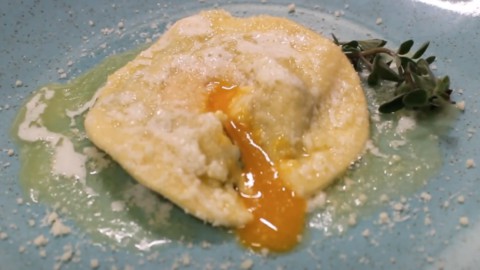And one day “the egg in ravioli” arrived. One of the symbolic dishes of Italian catering, not of the popular one but of haute cuisine, of what the chefs cooked for their masters. The egg in ravioli starts from the tradition of Emilian cuisine, or fresh egg pasta, and enriches it not only with a soft and traditional filling of ricotta and spinach but also with a sweet surprise: a creamy yolk that when sliced drips delicately into the center of the dish, releasing a series of flavors and aromas that conquer the palate. All seasoned with hazelnut butter, parmesan and white or black truffle depending on the season.
The egg in ravioli: the story
The dish dates back to the mid-70s and is created in the kitchens of San Domenico of Imola, a revolutionary restaurant, which today boasts the longest Michelin star rating (two since 1977). But to understand the origins of a dish that has revolutionized Italian gastronomy, we need to take a step back. The protagonist of this story is nino bergese, born in the early 900s, poor but with a great passion for cooking. He began working at a very young age in the kitchens of large families (at the time there were almost no restaurants), ending up over the years cooking for Humbert of Savoy and Duke of Aosta Emanuele Filiberto. At the end of the Second World War, with the disappearance of the old world of the aristocracy and the upper middle class, Bergese opened his first restaurant in Genoa, “The Saint”. Unlike popular taverns, his restaurant featured a refined cuisine, a perfect fusion between French and Italian. So much appreciated as to win two Michelin stars and attribute to Bergese the nickname of "cook of kings, king of cooks" by the gastronome and journalist Luigi Veronelli, becoming a real celebrity in the sector thanks also to his recipes published in the book "Mangiare da re" .
Then came Gianluigi Morini, a rich man with a passion for gastronomy who decided to open a restaurant in his family home in the heart of Imola. And he decided to call Bergese to lead his brigade, even though in the meantime the man had retired to private life. But unlike "La Santa", the Imola restaurant had a different cuisine that drew from the Italian experience, but with the desire to write a new chapter in the history of Italian haute cuisine.
And so the day of “egg in ravioli” came. It was 1974 when it was conceived by Bergese together with the very young Valentino Marcattili, but the Italian celebrity chef had doubts about his success, despite the raw materials being those typical of many traditional tortelli. But instead, the recipe forever marked the national high gastronomy, so much so that the French gastronomic journalist Henry Gault – proponent of the definition of “nouvelle cuisine” – described it as “a splendid and tasty living picture”.
After Bergese's death, Marcattili spent years training in France, when he returned to Italy he took over the leadership of the San Domenico kitchen, then passing the baton to his nephew Massimiliano Mascia born in 1983, a great talent in contemporary Italian cuisine.
Even today, this iconic dish is still on paper. Even if it was once removed because it overshadowed other firsts. Decision that triggered a real revolt, after two days and the prestigious stuffed ravioli returned to the list never to be removed.
Alongside this, however, there are also other dishes that have written the history of Italian gastronomy, such as the "Florentine cake”, prepared for the birthday of Prince Umberto, the “goose liver tile” with golden apple puree, brioche and port jelly, the “veal sirloin by Nino Bergese” with a smoked bacon cream.
And the story continues
The egg ravioli recipe
Ingredients:
For the ravioli:
200 g type 00 soft wheat flour
40 g spinach
200 g sheep's milk ricotta,ù
100 g Parmigiano Reggiano aged 24 months
7 eggs
extra virgin olive oil
sale
pepper
nutmeg
For the dressing:
200 g alpine butter
100 g Parmigiano Reggiano aged 24 months
50 g white truffle
Procedure:
First prepare the pasta. Mix the flour with 2 eggs and a pinch of salt to obtain a homogeneous mixture, cover with a cloth and leave to rest for about half an hour. In the meantime, wash and clean the spinach (removing the stems), sauté them in a pan with a drizzle of oil and a pinch of salt. Once cooked, leave them to cool in the blast chiller and, once cold, blend them with 50 grams of ricotta. Combine the rest with 100 grams of grated Parmesan, the yolk of an egg, grated nutmeg, salt and pepper, mixing without blending.
Take the dough back and roll the dough into a very thin sheet. You need to get 8 disks of 12 centimeters in diameter. Pour the filling into a pastry bag fitted with an 8 mm smooth nozzle and form a well about 3-4 centimeters high on half of the discs, placing an egg yolk and a pinch of salt in the center of each one. Close the ravioli with the ones left empty, moistening the edges with the leftover egg white, so that the edges are well sealed together.
At this point boil the ravioli, one at a time, in boiling salted water for exactly 2 minutes, remove them delicately with a hand and place one in each dish.
Separately, in a saucepan, melt and fry the butter until it reaches a hazelnut colour. Sprinkle the egg on the ravioli with parmesan, slice the white truffle, and complete the dish by slowly pouring in the butter which will melt the parmesan. When cut, the yolk should remain soft.
The recipe has remained the same, from the shape to the content up to cooking. Compared to the original, however, some doses of the dressing have changed, lightened in the addition of butter and Parmesan given that in the 70s it was eaten differently. Then there's the truffle, always raw but warmed up with hazelnut butter.





